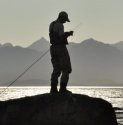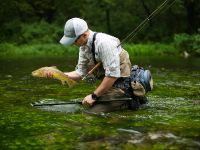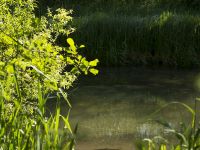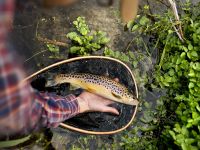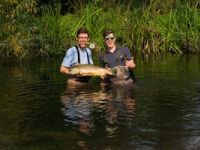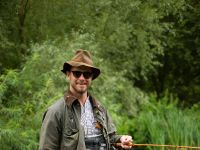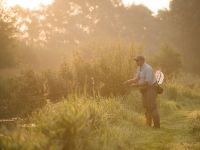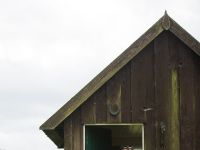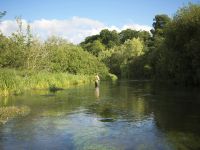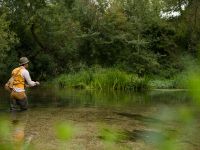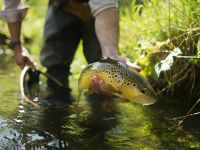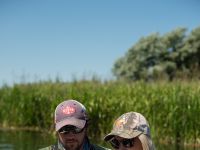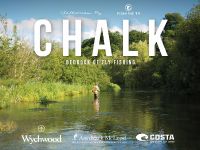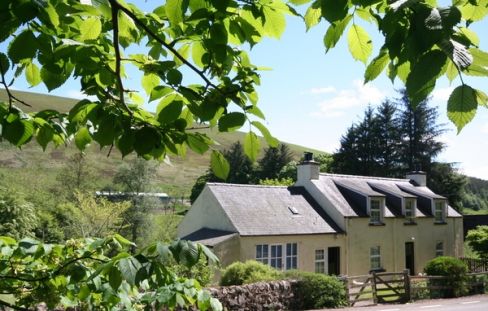Fd: Can you tell our users what the film CHALK – Bedrock of Fly Fishing is about?
The film focuses on the uniqueness of the chalkstreams of southern England (and beyond) and the people that live, work on and fish these rivers. We delved into the history of fly fishing, and how the sport was refined and developed on the rivers. We go off the beaten track too, looking at some of the smaller, lesser known rivers that perhaps aren’t on the radar of anglers across the globe.
Chalkstreams, and even their biology and the industrial heritage of the UK, have had so much influence on the sport of fly fishing that we had an abundance of material to showcase. CHALK takes viewers from the ancient history of the landscape, through the development of modern techniques and into the action of fishing a season on the river, including an incredible mayfly hatch It really is a celebration of these amazing places!
Fd: Why are the chalk streams so important in the history of fly fishing?
Chalkstreams are a unique habitat which exist only in England and a small part of Northern France. They are a natural phenomenon which is so special. The porous nature of chalk means that as rainwater filters through this geology it becomes extremely calcium rich, and slightly alkaline. It is this richness and purity which makes it an incredibly productive environment for all the animals to live in. The water is famously ‘gin-clear’, which makes it the perfect place to sight fish trout and other species.
During the Victorian era fishing became a pastime, rather than simply a means of catching food. It was because of the water clarity and the abundance of fly life, plus that good old Victorian inquisitive mind, that anglers began to study the habits and diet of the fish. Chalk explores this period and how fly fishing was refined, and also how it continues to be developed today.
More or less all methods of dry-fly, nymphing or ‘matching the hatch’ with a fly can trace a direct line back to pioneers such as Halford, Skues and Sawyer. We look at these great fly fishers and their relationship with the rivers which were the laboratories where they conducted their experiments. We visited where they made huge breakthroughs and even in Sawyer’s case speak to his son about growing up with someone on the cutting edge of the sport we all adore, and how his father approached his study of river life.
Fd: How did the idea of making the film come up? What are its goals or objectives?
Ed Burgass, the Commercial Director of Fishing TV had been thinking about the fact that these rivers are famous all over the world, and that they’ve had a huge influence on the sport of fly fishing, yet very few people know why or the stories behind it. There’s been a huge explosion in fly fishing films in the last few years but very little out of the UK or made by UK-based production teams, and it seemed like a perfect story with which to rectify that. Ed and George Browne at FishingTV put together a team to make the film come to life – getting Simon Cooper, of Fishing Breaks, in as the Executive Producer and script writer as well as ourselves from Chalkstream Fly to direct and film the project.
Although the film does have a bit of a message, the goal was mainly to celebrate the rivers and their unique history, rather than to bang a campaigning drum. We hope that by highlighting the magic of the chalkstreams, and showing the joy that they have brought people over decades and centuries, that we’ll inspire people to look after them for future generations.
Fd: What can you tell us about the pre-production process: contacting the experts, writing the script, etc.?
The film was funded using Kickstarter, a crowd funding resource that allowed us to gauge whether there would be an interest in the film in the first place. We were blown away by the reception the project received, and quickly raised, and exceeded, our target for production to begin.
We wanted the film to be a collaborative process, as it was the stories of people who have a relationship with the rivers that would really create interesting chapters to the film. Some anglers donated to be in the film which really helped us to demonstrate techniques, and find out what makes chalkstreams so special to the every-day fly fisher. Ed, George and Simon contacted river keepers, guides and experts to help really bring the film to life and lend some authority to the project.
We also wanted to show the rivers in all their scale, from majestic drone footage to the microscopic world beneath the surface, because ultimately it is the vast number of insects which thrive in chalkstreams which give the entire ecosystem life.
Filming and editing was over a 6 month period in the summer of 2017, and while there was a broad outline of the story we were trying to tell, it was only in the last few weeks, once most of the edit was done, that Simon and George could begin work on the voiceover script.
The film eventually premiered in November exactly six months to the day after the first day of shooting.
Fd: Can you tell us a bit more about the way these famed waters are protected nowadays?
The Environment Agency along with conservation charities such as the Wild Trout Trust, Wessex Chalkstream Trust and many others are helping to ease the pressure that modern society puts on the rivers. The film looks at how human influences, such as farming and water abstraction are causing problems that need to be addressed. Hopefully through shining a light on these issues we can protect the waters and help them flourish.
We didn’t want to only state the problems though. We also visit waters which have received amazing conservation work which has changed their futures. For example the River Wandle in the heart of London. Once little more than an open sewer it now is filled with sparkling gravel and flowing weed as well as beautiful wild brown trout. By celebrating these examples we hope people will be inspired to protect the amazing rivers on their doorstep.
Fd: What kind of challenges lie ahead?
We need to enlist the next generation of anglers. We also want to attract fly fishers who perhaps fish reservoirs, still-water, or spate rivers and get them excited about visiting chalkstreams too. There’s historically a perception that these places can be inaccessible to all but the privileged and wealthy, but we visited a whole array of rivers from the most exclusive to public waters and everything in between.
Stalking wild fish in crystal clear water is for many the ultimate thrill in freshwater fly fishing and we know that the more people who experience and appreciate this the more allies these rivers will have with which to overcome any future challenges.
Fd: How can one help or collaborate?
Join your local rivers trust, of the Wild Trout Trust. This is a great way to find out the health of the rivers and how you can help. They offer great opportunities to get involved, and volunteers can help clear rubbish, or even maintain the habitats or practice river restoration. The funding received from donations also helps research and future plans to protect the rivers. If you’re not in the UK, maybe the best thing is to encourage as many people as possible to watch CHALK, so that more people are aware of these incredible resources.
Fd: How can everyone watch the film?
CHALK is available through Fishing TV, an online platform for watching a range of amazing fishing content from all over the world. You can sign up for free and then rent or buy the film to view whenever you want: www.fishingtv.com/chalk

